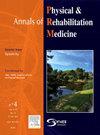骑车期间的生物力学和神经肌肉结果有助于中风后下肢感觉运动功能:一项系统综述
IF 4.6
3区 医学
Q1 REHABILITATION
Annals of Physical and Rehabilitation Medicine
Pub Date : 2025-03-19
DOI:10.1016/j.rehab.2025.101955
引用次数: 0
摘要
骑自行车是一种适当的康复干预,它在运动过程中对下肢的力量、平稳性、准确性和协调性带来了补充信息。本系统综述旨在确定生物力学和神经肌肉循环结果如何影响中风后下肢感觉运动功能,并量化它们与临床测量的关联水平。方法采用脑卒中、骑行和下肢评估相关关键词检索Medline、EMBASE和CINAHL数据库。这项研究包括了从开始到2024年7月的同行评议的原创文章,这些文章涉及中风后的成年人,他们用骑车来评估下肢感觉运动功能。检索、文章选择和数据提取由2名独立审稿人完成。采用改良的Downs和Black检查表评估偏倚风险。结果共纳入文献59篇(1290人),方法学质量从极低7%到极高88%。在循环方式和方案中观察到文章之间的方法异质性很高。这些文章包括100种不同的循环结果,可分为动力学、运动学和神经肌肉类。很少有文献记录骑车结果的心理测量特性(3篇文章)。12篇文章报道了运动循环结果与步态(n = 10)、平衡(n = 6)、运动性(n = 8)、运动循环结果与运动性(n = 2)、肌肉循环结果与平衡(n = 1)和运动性(n = 13)之间中度至非常强的显著相关性(相关系数值>;0.6)。结论本综述支持骑自行车可提供相关的骑自行车结果,有助于补充物理康复的临床评价。一些动力学、运动学和神经肌肉循环结果与中风后个体的下肢感觉运动功能密切相关。然而,方案和循环结果的临床特性需要未来的工作。试验注册号prospero: CRD42022342113。本文章由计算机程序翻译,如有差异,请以英文原文为准。
Biomechanical and neuromuscular outcomes during cycling help inform lower limb sensorimotor function after stroke: A systematic review
Background
Pedalling on a bicycle is an appropriate rehabilitation intervention which brings complementary information on strength, smoothness, accuracy, and coordination at the lower limbs during movement. This systematic review aims to identify how biomechanical and neuromuscular cycling outcomes inform lower limb sensorimotor function after stroke and to quantify their level of association with clinical measurements.
Methods
The Medline, EMBASE, and CINAHL databases were searched using keywords related to stroke, cycling, and lower limb assessment. The search included original peer-reviewed articles from inception to July 2024 involving adults after stroke for whom cycling was used to evaluate lower limb sensorimotor function. Search, article selection, and data extraction were done by 2 independent reviewers. The risk of bias was assessed with a modified Downs and Black checklist.
Results
Fifty-nine articles were included in the review (1290 individuals) with methodological quality ranging from very low 7 % to very high 88 %. High methodological heterogeneity among the articles was observed in cycling modalities and protocols. The articles included >100 different cycling outcomes which can be grouped into kinetic, kinematic, and neuromuscular categories. Psychometric properties of the cycling outcomes were rarely documented (3 articles). Twelve articles reported moderate to very strong significant associations (correlation coefficient values >0.6) of kinetic cycling outcomes with gait (n = 10), balance (n = 6), motricity (n = 8), of kinematic cycling outcomes with motricity (n = 2), and of muscular cycling outcomes with balance (n = 1), and motricity (n = 13).
Conclusion
The review supports that pedalling on a bicycle provides relevant cycling outcomes which could be useful to complement clinical evaluation in physical rehabilitation. Several kinetic, kinematic, and neuromuscular cycling outcomes are well correlated to lower limb sensorimotor function in individuals after stroke. However, the protocols and clinimetric properties of cycling outcomes require future work.
Trial registration
PROSPERO: CRD42022342113.
求助全文
通过发布文献求助,成功后即可免费获取论文全文。
去求助
来源期刊

Annals of Physical and Rehabilitation Medicine
Medicine-Rehabilitation
CiteScore
7.80
自引率
4.30%
发文量
136
审稿时长
34 days
期刊介绍:
Annals of Physical and Rehabilitation Medicine covers all areas of Rehabilitation and Physical Medicine; such as: methods of evaluation of motor, sensory, cognitive and visceral impairments; acute and chronic musculoskeletal disorders and pain; disabilities in adult and children ; processes of rehabilitation in orthopaedic, rhumatological, neurological, cardiovascular, pulmonary and urological diseases.
 求助内容:
求助内容: 应助结果提醒方式:
应助结果提醒方式:


